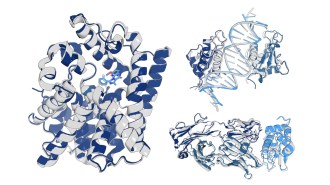- More than 2 years ago
Researchers have demonstrated that they can control how frequently a DNA-based nanodevice changes between two forms. Their “nanometronome” is the first example of such control over a single DNA molecule, the team contends.
The device consists of four strands of DNA, which in water assemble into a clover-shape structure. In the presence of magnesium ions, the assembly randomly switches between two stable, X-shaped forms, each with different strands paired into helices. The “ticking” rate between the two forms is mere milliseconds, the team reports.
To control the rate of ticking, Taekjip Ha of the University of Illinois at Urbana-Champaign and his colleagues added a short, overhanging DNA chain to one end of two of the strands. The two short chains complement each other. In the first DNA form, they can’t reach each other. In the second DNA form, they are close together and so pair up. This stabilizes the form and lengthens the amount of time it keeps this shape, Ha says.
The researchers measured the ticking-rate change with a technique called Förster resonance-energy transfer. They attached two fluorescent dye molecules at the same ends that had the overhanging DNA. In the first DNA form, when the dye molecules were far apart, they fluoresced green. But when the dye molecules were close together in the second DNA form, they fluoresce red.
As the group reports in the March Nano Letters, adding one DNA chain link, or base pair, to each overhanging sequence increases the lifetime of the red-fluorescence signal by a factor of three. The device may someday lead to a sensor that can detect a single base pair difference in a target-DNA sequence, Ha says.





